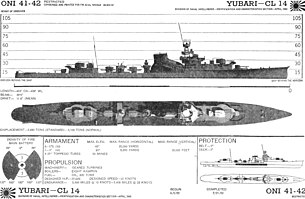| Japanese cruiser Yūbari | |
|---|---|
 "Yūbari" in 1924 | |
| Career | |
| Class and type: | light cruiser |
| Name: | Yūbari (夕張) |
| Namesake: | Yūbari River |
| Ordered: | October 1921 |
| Builder: | Sasebo Navy Yard |
| Laid down: | 5 June 1922 |
| Launched: | 5 March 1923 |
| Commissioned: | 23 July 1923 |
| Fate: | sunk 28 April 1944 by US submarine Bluegill |
| General characteristics | |
| Displacement: | 2,890 t (2,840 long tons) standard (designed); 3,141 t (3,091 long tons) full load (designed); 4,075 t (4,011 long tons) full load (actual) |
| Length: | 138.90 m (455.7 ft) |
| Beam: | 12.04 m (39.5 ft) |
| Draft: | 3.58 m (11.7 ft) |
| Installed power: | 43,060 kW (57,740 hp) |
| Propulsion: |
3 × geared steam turbines 8 × Kanpon boilers 3 × shafts |
| Speed: | 35.5 kn (65.7 km/h; 40.9 mph) |
| Range: | 5,000 nmi (9,300 km; 5,800 mi) at 14 kn (26 km/h; 16 mph) |
| Complement: | 328 |
| Armament: | 6 × 140 mm (5.5 in) guns (2x2, 2x1), 1 × 76.2 mm (3 in) AA gun, 2 × machine guns, 4 × 610 mm (24 in) torpedo tubes (2x2), 34 × mines |
| Armor: |
|
Yūbari (夕張) was a light cruiser built between 1922 and 1923 for the Imperial Japanese Navy. She fought in World War II and was sunk by the US Navy.

World War II recognition drawings of Yubari
Design[]
The ship originated as an experimental scout cruiser that would have the combat potential of the standard 5,000 t (4,900 long tons) Japanese light cruisers on a much lighter ship. The ship was designed by Lt. Cmdr. Fujimoto Kikuo under the direction of the head of the IJN Shipbuilding Section, Constructor Captain Yuzuru Hiraga. The entire main battery was mounted on the centre line in turrets. To save weight, the armor was integrated into the hull structure. The forecastle was given significant flare to improve seakeeping. Destroyer-type machinery was used to save weight, with eight oil-fired Kanpon boilers trunked into a single large funnel.[1]
Many of the Yubari's design features were used in the contemporaneous Furutaka-class of heavy cruisers, and in subsequent Japanese warships.
The ship was completed 419 t (412 long tons) (13%) over the designed displacement, resulting in an extra foot of draft and a loss of 1.5 kn (2.8 km/h; 1.7 mph) in designed speed.[2]
The ship had a significant refit in early 1944 when the two single 140 mm (5.5 in) guns were removed, one 120 mm (4.7 in) AA gun (in the "A" position) and six twin and one triple 25 mm AA guns were added together with a search radar and depth charges.[3]
Service[]
Yubari served in the Pacific during World War II.
She was based out of Truk from late 1941 through 1942.[4] Yubari was the flagship of the Japanese invasion force during the invasion of Wake Island. She led both invasion attempts on 11 and 23 December 1941.[5]
Subsequently Yubari and her destroyers participated in the capture of Rabaul. She was next assigned as the flagship of the Port Moresby Attack Force during Operation MO, returning to Truk when the operation was cancelled.[6]
Beginning in mid-1942, she took part in the Solomon Islands Campaign, including landing personnel on Guadalcanal to construct an airfield, and later participated in the Battle of Savo Island.[7][8] One of the torpedoes which sank the US cruiser Vincennes has been attributed to her.
Yubari was sunk on 27 April 1944 off Palau by the US submarine Bluegill.[9]
See also[]
| Wikimedia Commons has media related to Yubari. |
References[]
Notes[]
- ↑ Lacroix, Japanese Cruisers, p. 41,45,46
- ↑ Lacroix, Japanese Cruisers, p. 44
- ↑ Lacroix, Japanese Cruisers, p. 368-369
- ↑ Lacroix, Japanese Cruisers, p. 363-366
- ↑ Dull, A Battle History..., p. 24-25
- ↑ Lacroix, Japanese Cruisers, p. 364
- ↑ Lacroix, Japanese Cruisers, p. 368
- ↑ Dull, A Battle History..., p. 187
- ↑ U. S. Navy Dictionary of American Naval Fighting Ships, "U.S.S. Bluegill, SS-242", Web. 23 Feb 2013. http://www.history.navy.mil/danfs/b7/bluegill-i.htm
Books[]
- Dull, Paul S. (1978). A Battle History of the Imperial Japanese Navy, 1941-1945. Naval Institute Press. ISBN 0-87021-097-1.
- Lacroix, Eric; Linton Wells (1997). Japanese Cruisers of the Pacific War. Naval Institute Press. ISBN 0-87021-311-3.
External links[]
| Wikimedia Commons has media related to Japanese cruiser Yubari. |
| |||||||||||||||||||||||||||||||||||||||||||||||||||||||||||||||||||||||||
Coordinates: 5°38′00″N 131°45′00″E / 5.63333°N 131.75°E
The original article can be found at Japanese cruiser Yūbari and the edit history here.